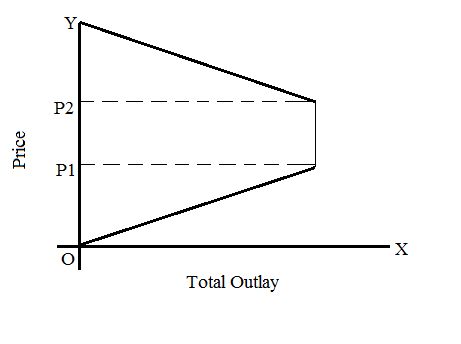Measurement of Price Elasticity of Demand
Here we understand the methods used to measure price elasticity of demand in detailed.

Do you have similar website/ Product?
Show in this page just for only
$2 (for a month)

0/60
0/180
Measurement of Price Elasticity of Demand

 As shown in above figure, total outlay is measured along the X axis and price is measured along Y axis. Over the price range P3 to P2, demand is more elastic, because total outlay increases with the fall in price. Over the price range P2 to P1, demand is unitary elastic in nature, because total outlay remains constant. Over the price range P1 to O, demand is less elastic because total outlay decreases with the fall in price.
As shown in above figure, total outlay is measured along the X axis and price is measured along Y axis. Over the price range P3 to P2, demand is more elastic, because total outlay increases with the fall in price. Over the price range P2 to P1, demand is unitary elastic in nature, because total outlay remains constant. Over the price range P1 to O, demand is less elastic because total outlay decreases with the fall in price.
First, we understand the meaning of Price Elasticity of Demand:
Price Elasticity of Demand:
"Price elasticity of demand is defined as the percentage change in quantity demanded divided by the percentage change in price."
Now, we will discuss the methods use to measure Price elasticity of demand in detail.
Measurement of Price Elasticity of Demand:
Two most important methods used to measure price elasticity of demand are total outlay method and percentage change method.
Total Outlay Method:
According to Professor Marshal, total outlay method is used to measure price elasticity of demand. Total outlay is obtained by multiplying total quantity purchased by per unit price.
TQ = q x p, where TQ is the total outlay
q represents total quantity purchased and
p represents per unit price of the commodity.
According to law of demand, demand expands with the fall in price. Price fall is a factor which tends to reduce total outlay, but expansion of demand is a factor tends to increase total outlay. There may be three possibilities: Total outlay may decrease with the fall the price or total outlay may remain constant inspite of fall in price or total outlay may increase with the fall in price. We understand this clearly with examples-
(i) If total outlay decreases with the fall in price, demand said to be inelastic or less elastic, for eg-
Here, in this case demand expands with the fall in p, but TQ gets reduced.
(ii) If total outlay remains constant inspite of fall in price, demand is said to be unitary elastic, for eg-
In this case, demand expands with the fall in p, yet TQ is constant.
(iii) If total outlay increases with the fall in price, demand is said to be elastic or more elastic in nature, for eg-
Here, in this case demand expands with the fall in price and TQ also goes up.
All these possibilities can be expressed in figure as follows:

Now, we will discuss about second method that is Percentage Change Method.
Percentage Change Method:
This method was introduced by Dr. Flux.
The above discuss Outlay method helps us know whether demand is more or less elastic, it does not give us exact value of price elasticity of demand.
Percentage Change Method, gives us exact value and therefore is considered as superior to total outlay method. Under this method, percentage change in demand is to be compared with the percentage change in price. Symbolically represented as-
Ep = ?D/D ÷ ?P/P
= ?D/D × P/?P
= ?D/?P × P/D
Where D = Original quantity demanded
? = Change in quantity demanded
P = Original price
?P = Change in price
Ep = Price elasticity of demand.
CONTINUE READING
Elasticity of Demand - Price Elasticity of Demand - Measurement of Price Elasticity of Demand.
Kinnari
Tech writer at NewsandStory
